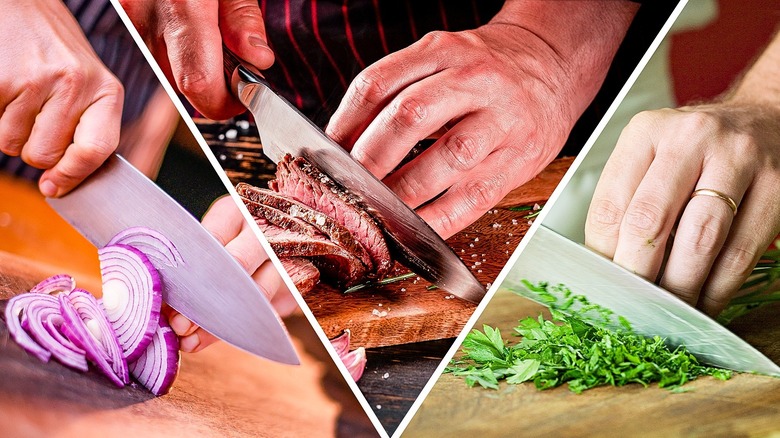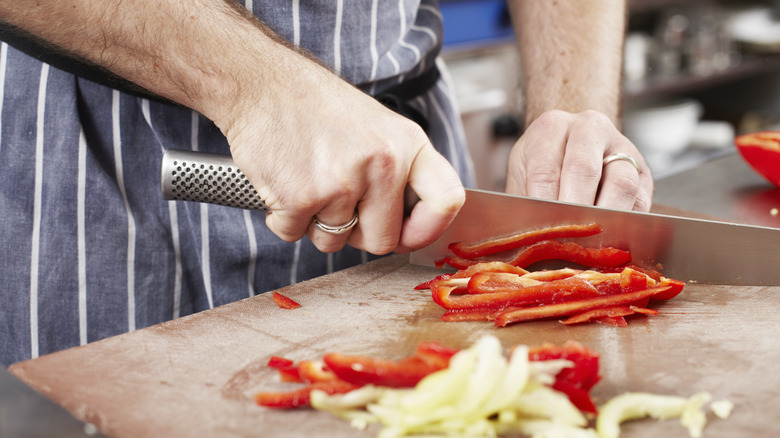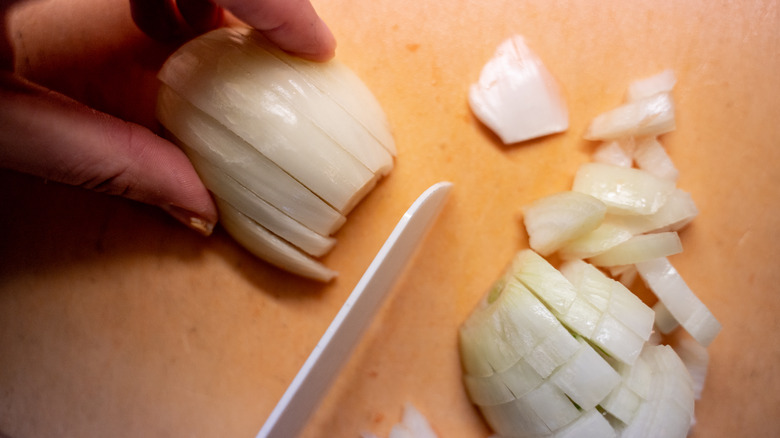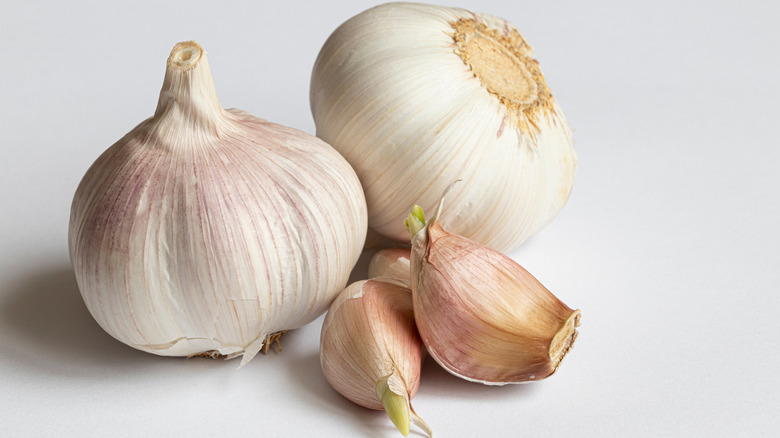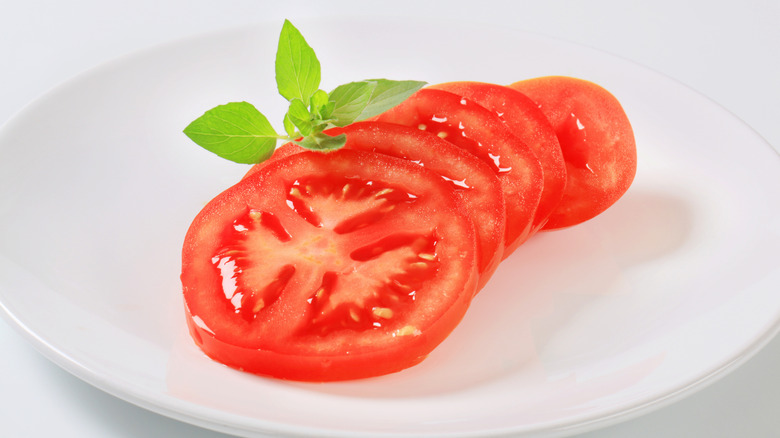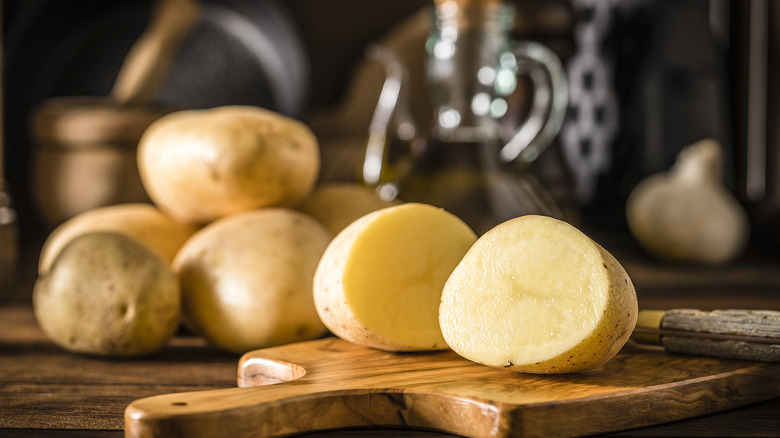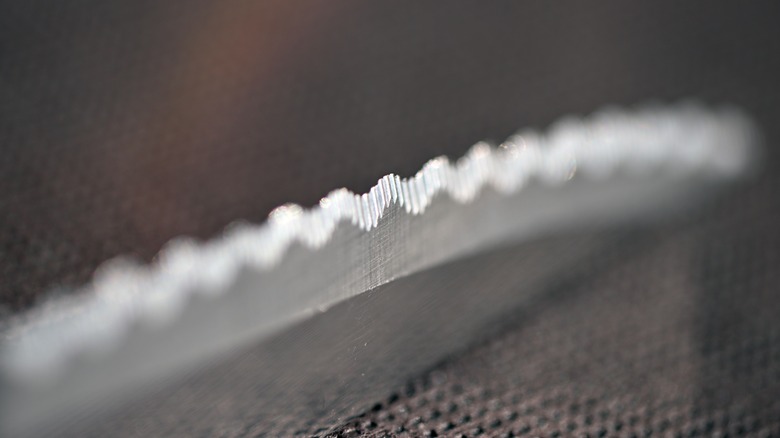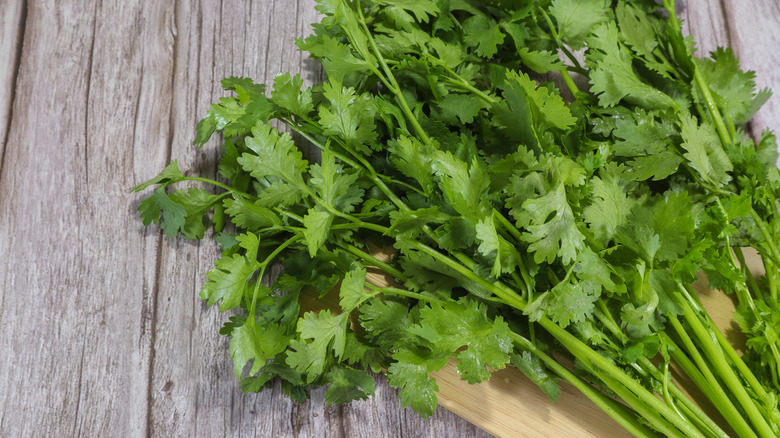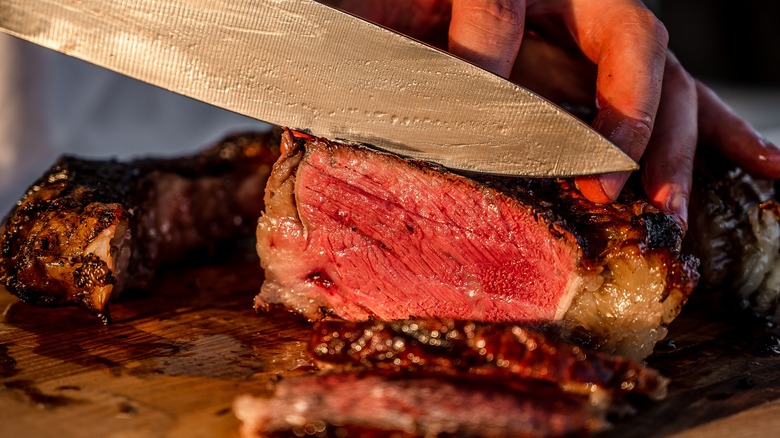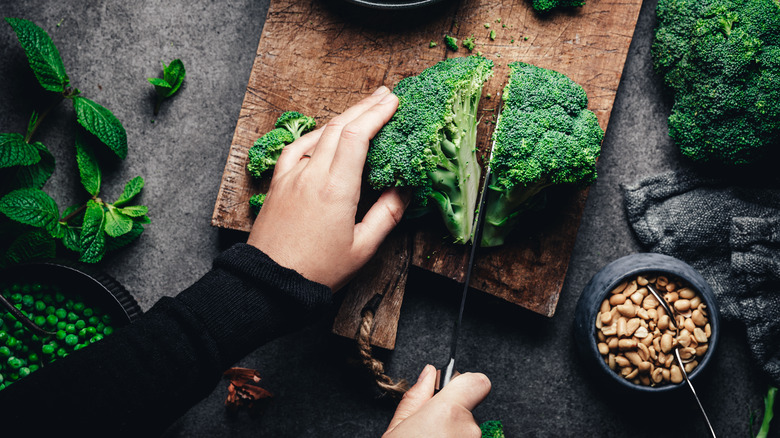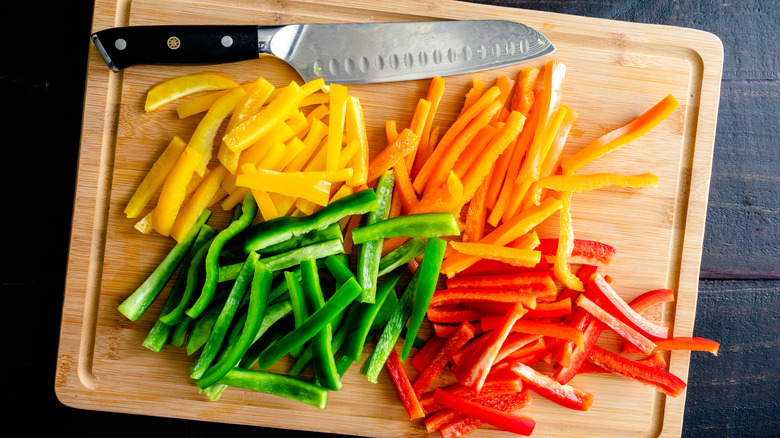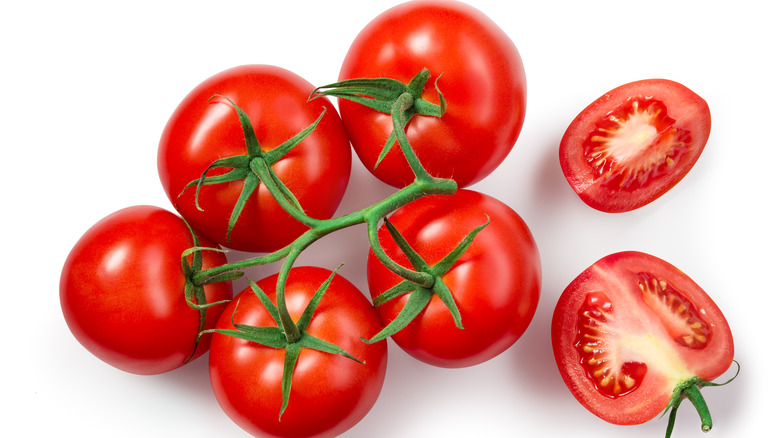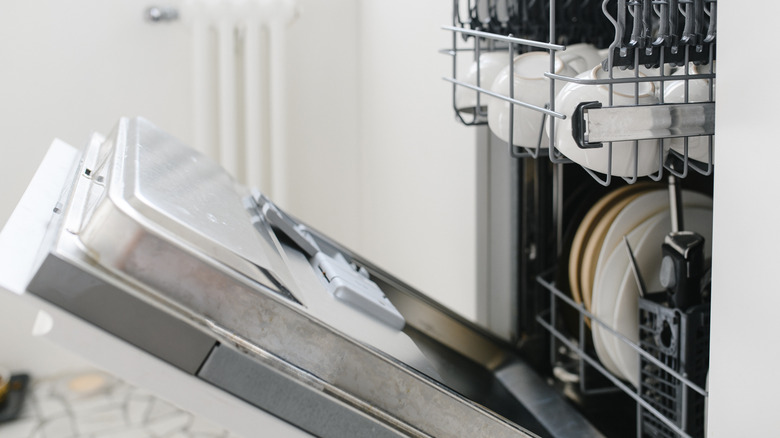14 Kitchen Knife Hacks You Need To Master
If you are preparing a meal from scratch, you will most likely require the use of your kitchen knives to get the job done. Knives are one of the most important tools for chefs, so much so that they are allowed to bring their own set when appearing in cooking competitions, according to The A.V. Club.
A good set of knives can make or break the end result when preparing a dish, so it's important to invest in quality tools and know how to use them properly. There are countless knife brands out there, including many celebrity chef brands, so picking the right set can be daunting. Once you have acquired your knives, it's time to get familiar with them.
Beyond simply slicing and chopping your fruits and vegetables, there are actually many different hacks out there for making your life much easier when using knives. Whether it is mastering different cutting techniques or discovering unique uses for your knives, the following hacks are sure to assist you the next time you pick one up.
1. Learn different knife cuts
You may think the way you cut ingredients doesn't make much of a difference when cooking. After all, won't it all taste the same? But depending on the kind of dish you are preparing, specific kitchen knife methods are more appropriate than others. That's why it's important to understand terminology pertaining to cutting techniques.
Knowing the primary ways of cutting fruits, vegetables, and other ingredients will save you a ton of time when prepping your next meal. In addition, it can open your culinary world to a slew of new cooking methods that breathe new life into your dishes. There are a number of different cuts out there, but sticking to five basic knife cuts is sufficient. There's the batonnet (the matchstick knife cut), brunoise (a specific kind of dice), chiffonade (a ribbon-like cut specifically for leafy vegetables), Julienne (a small matchstick knife cut), and Macédoine (a quarter-inch-square cube).
2. Use rubber bands to grip your knife better
According to Porch, knives are responsible for thousands of injuries each year, sending people to the hospital with varying levels of cuts. These injuries often occur when someone is slicing too quickly or chopping oddly shaped ingredients, causing their hand to slip. Handling kitchen knives should not scare you out of the kitchen, and there are many methods you can master that make working with knives much safer. Some techniques, like using the claw grip when holding items with your non-cutting hand, will better protect your fingers.
Other methods involve improving your grip on the knife itself. Some professional chefs will tell you to grip the knife at the base of the handle — almost so that you are partially gripping the blade's spine. Another DIY trick is to take several rubber bands and wrap them around the handle of the knife. The rubber bands will provide an easy grip on the knife handle, allowing you to slice your ingredients without fear of the knife easily slipping and cutting your hand. Just do not let the sturdier grip lead you into a false sense of security. You still want to chop or slice at a safe speed.
3. Roll the knife when chopping
If you watch a cooking show on television, you might marvel at how effortlessly a professional chef chops vegetables. While it may feel like it takes you an hour to chop an onion, the professional chef can have it diced in a matter of seconds. This takes many years of practice, but there are specific techniques that you can learn just as quickly without heading off to culinary school. It is one thing to hold your knife right, but mastering the exact slicing motion is just as important.
When chopping your ingredients, you do not necessarily want to use a chopping motion. Instead, you want to rock and roll the knife. Not only is this an easier way to slice your favorite foods, but it is also better for knives. The sharp blades were designed for horizontal, rolling motions along hard surfaces like your cutting board. Some up-and-down movements may quicken the process of the blades growing dull.
4. Leave the ends of your onions intact while slicing
Finding a new recipe to try can be exciting until you read through the instructions and realize you have to chop an onion. This is an unpleasant experience that has vexed home cooks for years. How can such a fundamental step in the cooking process be so harrowing and borderline painful?
For many, the solution is to buy pre-chopped onion at the grocery store, which can cost you extra. Other solutions involve investing in different kitchen gadgets specifically designed for chopping an entire onion in one swift motion. There are many tricks to try. Chopping an onion like professional chef Gordon Ramsay, as he demonstrates on YouTube, can be boiled down to one slicing technique that gets the job done quickly and efficiently.
The method involves chopping your onion in half lengthwise from root to stem. Then, make parallel cuts into the onion towards the root, being careful not to cut all the way through the other end. Once you have worked down the onion, rotate and slice perpendicular to the slices you just made. You will find that you just quickly diced the onion in just a few quick motions before the onion had any chance of wreaking havoc on your sinuses. Also, you want to make sure you have the sharpest blade possible for the cleanest cut that will reduce the amount of tear-inducing fumes being released.
5. Smash garlic with your knife
Garlic is an incredible ingredient that can add a robust flavor to any dish. Similar to onions, garlic can also cause a major holdup in the preparation process. Garlic cloves are covered in a papery skin that can be a pain to remove, resulting in your recipe taking way more time than necessary. In those situations, you can use a simple hack with a kitchen knife that will instantly peel any garlic clove.
To peel your garlic in seconds, as Gordon Ramsay does on YouTube, place the clove on a cutting board or clean kitchen counter and place a flat kitchen knife over it. You want to make sure that you use a knife that is wide enough so that the blade covers the clove. Then, take the heel of your palm and smash the garlic clove with the flat side of your knife. The contact will instantly separate the skin so that it easily peels off the clove. Now, you can add any amount of garlic to your favorite recipe without worrying about the process taking too much time.
6. Use the sharpest knives when slicing tomatoes
Whether you are using them in a sandwich or a salad, tomatoes add a refreshing flavor and antioxidants to any meal. Tomatoes are also known for being incredibly juicy, thanks to the fact that it is made up of 95% water. That can make slicing a tomato a bit tricky, and if you aren't careful, you may soon find your cutting board covered in juice. The next time you have to slice tomatoes, keep these kitchen knife tips in mind to avoid making a mess.
Many professionals say the right way to cut a tomato is to use a serrated knife, due to its ability to pierce through its tough skin easily. If you struggle too much when slicing the tomato, you may wind up squeezing out the juices and guts of the tomato. A flat knife works as well, but you want to make sure it is extra sharp. Using the correct knife will make your tomato cutting far less messy, whether you want slices, wedges, or diced pieces.
7. Cut round fruits and veggies in half first
Learning how to handle sharp kitchen knives can feel like a daunting task. All of your progress can come to a screeching halt when dealing with round ingredients. It only takes one close call to shy away from any round ingredient, but they are pretty common, so learning how to handle them safely is key. Potatoes, onions, and even cucumbers can cause your knife skills to slow to a snail's pace. After all, it's easy to picture a worst-case scenario of a potato suddenly rolling out from under you while handling a sharp object.
There is an easy remedy to this nightmare. Simply cut all of your round fruits and vegetables in half first, and then lay the flat side down on the cutting board to prevent rolling. Having the fruit or vegetable's flat side facing down will stabilize the ingredient, allowing you to slice away without any risk of rolling. The next time you want to cut your apple into slices for a quick snack, there's no need to worry about any potential injuries.
8. Use a serrated knife when chopping fruit
For many amateur home chefs, serrated knives might be reserved only for ingredients with super-tough exteriors or harder-to-cut surfaces like a loaf of sourdough bread. But their utility extends far beyond that.
Using a serrated bread knife to cut fruit is the way to go. The reason behind this is in its design. Serrated bread knives are longer and thinner than your standard kitchen knife, making them ideal for delicate foods like tomatoes. Of course, it's also the perfect knife to choose when handling tough foods like squash or pineapple, making it one of the more versatile tools in the kitchen. The next time you are making a sandwich and need to slice up a tomato, skip the kitchen knife and opt for your bread knife instead. You may be surprised at how gently it will slice without compromising the structure of the ingredient.
9. Use the knife spine to activate herbs
The best kitchen tools are ones that have multiple uses beyond their core function. Many of these utilities are discovered over time, with chefs developing techniques and methods of cooking by thinking outside of the box. While knives are of course meant to slice and chop your fruits, vegetables, herbs, and starches, they can also be used in a way that does not involve the sharp blade whatsoever.
Herbs are a great way to enhance your dish with an added bold flavor. But in order to use certain herbs to their full potential, they need to be activated. That is where your kitchen knife comes in. Carefully position the knife above your herbs with the blade facing up, and strike the ingredient with the spine of the knife. The blunt side of the knife will not chop the herb, but its sleek edge will make contact in a way that releases the aroma and flavor, better incorporating itself into the dish.
Of course, remembering the spine of the knife is also useful when slicing and chopping. You can get a much better grip on the knife if you pinch the spine when cutting whatever it is you are cutting, preventing injury.
10. Slice your meat against the grain
There are few things more satisfying than totally nailing the perfect steak at home. Recreating your favorite dish from the local steakhouse may seem like a daunting task, but once you give it a go, you may realize that cooking steak is actually a fairly simple process. That said, there are many steps along the way that amateur home cooks often overlook, and by doing so, they miss out on maximum flavor and texture.
There are several boxes you want to check while cooking or grilling your steak, but one of the most important steps actually happens when it comes off the heat. After all, a serving of steak is a little bit to eat in one piece, so you will have to slice into it at some point. While it may seem intuitive to slice along the grain, you actually want to give yourself a little more work and slice against it. Slicing against the grain gives you more tenderness in each bite, which will help give you that restaurant-quality steak.
11. Cut broccoli and cauliflower from the core
According to Healthline, cruciferous vegetables like broccoli and cauliflower are important foods to include in your diet thanks to their many health benefits. But buying a full head of broccoli or cauliflower means taking some time to cut it into smaller pieces before cooking. If you have ever tried to do so, then you are probably well aware of the mess it can create. Tiny pieces of broccoli are strewn across your cutting board, leaving you to find them in the crevices of your kitchen for weeks to come.
The mess can be avoided, however, with the proper cutting techniques. Celebrity chef Ina Garten points out in an Instagram post that the trick is to not cut into cauliflower or broccoli from the top, but rather flip the vegetable upside-down and cut out the core first. From there, you can easily cut into the individual sections at their base for a mess-free chopping experience. This will give you perfectly trimmed florets ready for roasting without extensive cleanup.
12. Lay bell peppers on their side and slice horizontally
Bell peppers are popular vegetables for their refreshing taste and crunchy texture. Perfect as-is for cold salads, as well as cooked for toppings for your tacos, peppers are quite versatile and can be prepared in a number of different ways. The first step, no matter how you choose to use them, is to slice and chop them into smaller pieces. Once you cut into a pepper, you will quickly find that a mess is on your hands if you do not get a handle on its seeds and membrane.
Bell peppers contain many seeds attached to their core, and the right slicing technique will minimize the cleanup. The first step is cutting the top and bottom off of the pepper. Then with the pepper laying on its side, slice it horizontally. As you go, start to roll the pepper away from the knife, with the knife slicing along the edge as you go. Once you reach the end, you will find that you effortlessly removed the seeds and are ready to continue chopping the pepper into whatever size pieces you need.
13. Use tomatoes to know how sharp your knives are
Like most kitchen tools, taking care of your knives is essential in making sure they have a long, useful life. Neglecting your knives can quickly lead to them growing dull and useless over time, so it is important to periodically sharpen them. But how do you know when it is time to sharpen your knives? There is actually a useful hack using tomatoes to check the sharpness.
According to a series of professional cooking tips offered by chef Jacques Pépin for Bon Appétit, a ripe tomato is all you need to check the sharpness of your knives. If your knife is at an ideal level of sharpness, it should be able to slice into a tomato without any mess. But if the knife is dull, the tomato will not slice neatly and will instead lose its juice as you cut through it.
If it is time to sharpen, your knife set may have come with a sharpener tool. Otherwise, the bottom of a ceramic coffee mug also works wonders as an unexpected item you can use to sharpen any kitchen knife. You definitely do not want to ignore a dull knife, as chopping ingredients with dull knives is actually more dangerous for you. So if you have a ripe tomato on hand, it may be time to check your knives.
14. Don't send knives through the dishwasher
Knives are some of the most important tools in your kitchen, so taking care of them should be a priority. That means sharpening them regularly, using them for their intended purpose, and perfecting the right slicing techniques to avoid any unnecessary wear and tear on the blade. When it is time to clean your knives, you may mindlessly toss them into the dishwasher.
While the dishwasher works fine for many utensils, your sharp kitchen knives need to avoid going in there at all costs. Dishwashers can actually damage your knives over time, as the combination of dish detergent, hot water, and other items can erode the quality of the blades. It is crucial to hand-wash your knives after each use. It only takes a few moments and will extend the life of your knives significantly. A good set of kitchen knives is not inexpensive, so you want to make sure you do everything in your power to keep them sharp and useful.
